2017 Lincoln Continental AWD Reserve Review: American Cheese
- Bold styling is eye-catching
- 3.0 twin-turbo V6 has plenty of power
- AWD makes the Continental sure-footed
- Class-above space in the cabin
- Six-speed gearbox struggles at times
- Cabin finish lacks polish in places
- Gets expensive with the right toys added
The 2017 Lincoln Continental had a strong start: indeed, few auto-show cars capture the spirit of their predecessors – and the attention of the buying public – like the 2015 Continental Concept did. Unapologetic in its lavishly-chromed exterior and purple shag-pile cabin, it was far from the milquetoast sedans that had ill-borne the Continental name up until their demise in the early '00s. Instead, it summoned memories of icons from the fifties and sixties, a conspicuous and distinctive play on the "American Luxury" slogan of the brand.
A surprising amount of that concept made it through to the production model, even if hopes for rear-hinged "suicide doors" didn't make it past the accountants. The 2017 Continental is a big, imposing car. Though ostensibly an E-Class competitor, at almost seventeen feet long the Continental is closer in size to the S-Class. The core shape is solid and slab-sided, punctuated with some flowing creases; Lincoln's chrome-heavy grille pays not-so-subtle homage to Bentley. It all works better at the front than the back, which feels like an afterthought.
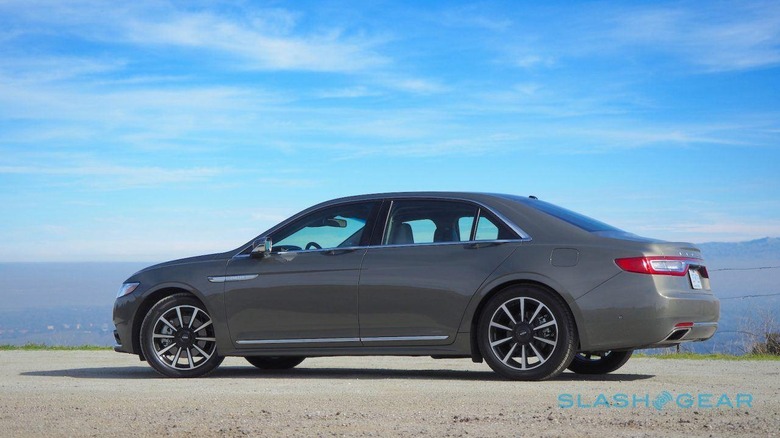
Lincoln offers three engines on the Continental, kicking off with a naturally-aspirated 3.7-liter V6, then a 2.7-liter twin-turbo V6, and finally the 3.0-liter twin-turbo V6 in this particular car. All-wheel drive is standard with the most powerful engine; the others have a choice of FWD or AWD. No matter the engine, there's a six-speed automatic transmission and twin piston brakes at the front with solid brakes at the back.
The Continental always had a reputation as a boulevard cruiser, and Lincoln hasn't strayed too far from that with this newest model. Continuously Controlled Damping (CCD) gives the car a settled poise that belies its not-inconsiderable size. Deeper potholes and ill-kept road surfaces will send some rumbles into the cabin, but cornering is flat and the AWD system has decent grip.
Though you get 400 horsepower and 400 lb-ft. of torque with the 3.0-liter twin-turbo V6, Lincoln is adamant that it hasn't tried to make a sports sedan. It's certainly not slow off the line, but the transmission confirms the Continental's priorities. Not only is it lacking a few ratios in comparison to rivals, it requires a heavy right foot to provoke a downshift and then suddenly surges, betraying the car's grace in the process.
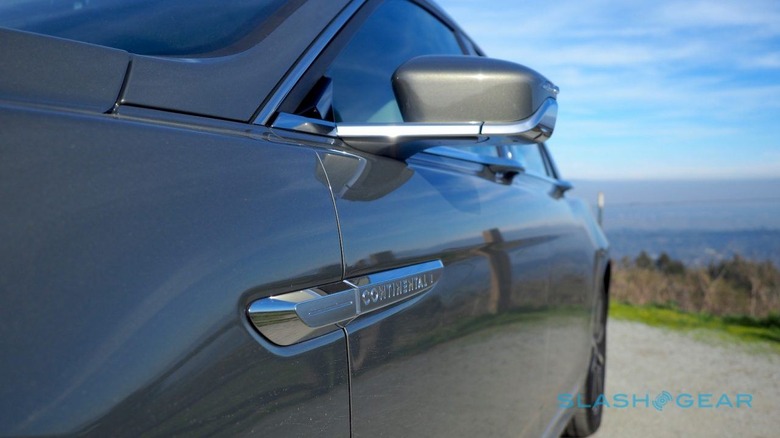
Three drive modes are on offer – Comfort, Normal, and Sport – which all deliver on their promise. Unfortunately there's no single button to switch between them: instead you have to dig through menus on the digital instrumentation display with switches on the steering wheel. While you can assign a different mode to the regular Drive and Sport transmission settings, I'd still prefer to be able to toggle them from a dedicated control. In my mixed driving I saw 16.7 mpg combined, short of the 19 mpg Lincoln suggests.
In some places, Lincoln's detailing borders on the sublime. The chrome ribbons that run the shoulder-line of the car and integrate sinuous looping door handles are a good example; the electronically-actuated doors themselves, are another. Lincoln's engineers have used a clever combination of springs and weighting to somehow give the doors a reassuring feeling of heft while still leaving them easy to open and close.
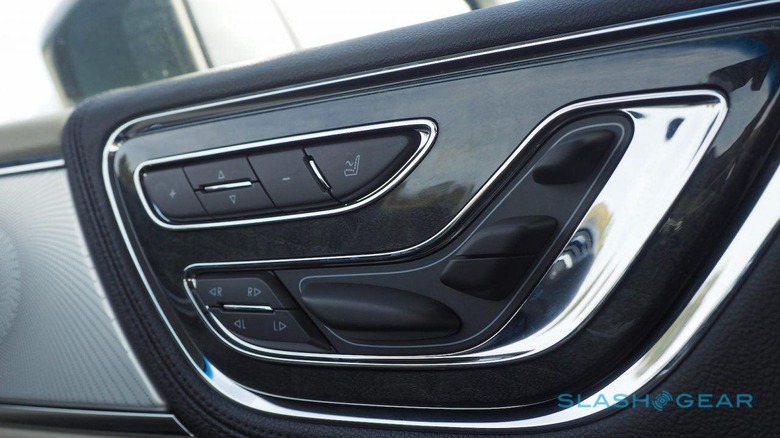
Climb inside, and the $1,500 "Perfect Position" seats offer boggling 30-way adjustment. A combination of buttons and sliders on the door panel, and more granular controls on the center touchscreen, encourage you to spend fifteen minutes tweaking each of the sliding, inflating, squeezing sections of a seat that looks a little like a face-hugger from Alien. Weirdly given all the air bladders involved, though there's a massage feature, it only goes halfway up your back.
You could argue that the lashings of chrome trim and the ornate speaker grilles are over-designed, but they go some way to capturing the ostentatious charm of the original Continental Concept that impressed so many people ahead of the production version. Lincoln's optional Revel audio system sounds great and, though SYNC3 isn't my favorite infotainment system, it's clean and straightforward to use. With the Rear Seat Package added, those in the back get separate control over multimedia and HVAC along with their extensive legroom.
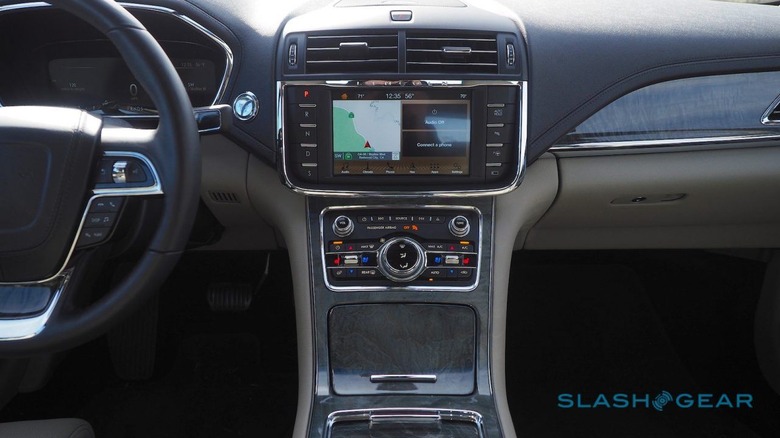
Elsewhere, though, things haven't been so well thought-through. Automakers are (rightly) obsessed with "touch points" – the places your fingers come into contact with most frequently, and which have a disproportionate impact on perceived quality – and the Continental doesn't manage a clean sweep. The transmission control buttons that run along the side of the touchscreen may help free up the center console versus a traditional stick, but they're plasticky and could've been lifted from any Ford.
Many of the chromed buttons and toggle-switches feel similarly plasticky; the wood trim may be real, but the heavy lacquer treatment robs it of its authenticity. Similarly, though Lincoln may have wrapped the dash-top of this high-end Reserve model in real leather, it picked hide that has the same texture as the elephant-butt plastic found in molded swathes in cheaper cars. Cadillac's CT6 is more spritely than the Lincoln, and its cabin feels both more sober and more cohesive; the Volvo S90's cabin manages to be infinitely more charming and distinctive than either American car, despite having a similar price tag.
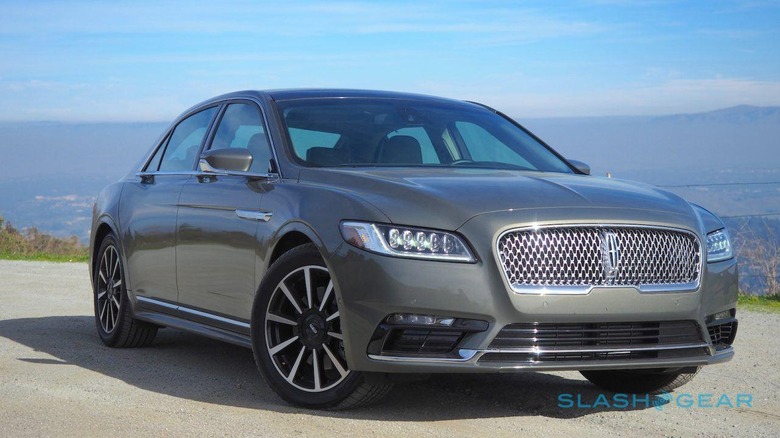
Indeed, pricing for the 2017 Continental can easily spiral upward. The 3.0-liter twin-turbo V6 AWD starts at $55,915 plus $925 destination, but by the time you add the fancy seats, tech and climate packages, and other niceties, you're looking at $74,705. That puts you in the heart of Mercedes-Benz E300 4MATIC territory and, while that might be the "mainstream" choice, it's hard to argue with the three-pointed-star's cachet.
Choosing the Continental, then, has to be a purposeful decision. Coy, it's not, though I think the "love it or hate it" design was the right route for Lincoln to take. There's no shortage of premium sedans making restrained plays for the market Mercedes, BMW, and Audi do so well in; like the Continental, they undercut their German rivals, but competitive price alone is a soulless play in this segment. Better, surely, to capture the hearts of drivers, and win them over for more than just the possibility of saving a few thousand dollars. On that basis, with its brash attitude and a self-confidence that just skirts the line of caricature, just a few tweaks could see the Continental start the charm offensive Lincoln needs.
